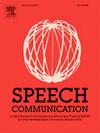Lexical, syntactic, semantic and acoustic entrainment in Slovak, Spanish, English, and Hungarian: A cross-linguistic comparison
IF 3
3区 计算机科学
Q2 ACOUSTICS
引用次数: 0
Abstract
Entrainment is the tendency of speakers to reuse each other’s linguistic material, including lexical, syntactic, semantic, or acoustic–prosodic, during a conversation. While entrainment has been studied in English and other Germanic languages, it is less researched in other language groups. In this study, we evaluated lexical, syntactic, semantic, and acoustic–prosodic entrainment in four comparable spoken corpora of four typologically different languages (English, Slovak, Spanish, and Hungarian) using comparable tools and methodologies based on DNN embeddings. Our cross-linguistic comparison revealed that Hungarian speakers are closer to their interlocutors and more consistent with their own linguistic features when compared to English, Slovak, and Spanish speakers. Further, comparison across different linguistic levels within each language revealed that speakers are closest to their partners and most consistent with their own linguistic features at the acoustic level, followed by semantic, lexical, and syntactic levels. Examining the four languages separately, we found that people’s tendency to be close to each other at each turn (proximity) varies at different linguistic levels in different languages. Additionally, we found that entrainment in lexical, syntactic, semantic, and acoustic–prosodic features are positively correlated in all four datasets. Our results are relevant for the predictions of Interactive Alignment theory (Pickering and Garrod, 2004) and may facilitate implementing entrainment functionality in human–machine interactions (HMI).
斯洛伐克语、西班牙语、英语和匈牙利语的词汇、句法、语义和声学夹带:跨语言比较
娱乐是说话者在谈话中重复使用彼此语言材料的趋势,包括词汇、句法、语义或声学韵律。虽然在英语和其他日耳曼语言中对夹带进行了研究,但在其他语言群体中研究较少。在这项研究中,我们使用基于深度神经网络嵌入的可比工具和方法,评估了四种不同类型语言(英语、斯洛伐克语、西班牙语和匈牙利语)的四种可比较口语语料库的词汇、句法、语义和声学韵律的影响。我们的跨语言比较显示,与说英语、斯洛伐克语和西班牙语的人相比,说匈牙利语的人更接近他们的对话者,更符合他们自己的语言特征。此外,在每种语言的不同语言水平之间的比较表明,说话者在声学水平上与他们的伴侣最接近,并且与他们自己的语言特征最一致,其次是语义、词汇和句法水平。我们对这四种语言分别进行了研究,发现在不同语言的不同语言层次上,人们在每个转折点(接近度)上彼此接近的倾向是不同的。此外,我们发现词汇、句法、语义和声学韵律特征在所有四个数据集中都是正相关的。我们的结果与交互对齐理论(Pickering and Garrod, 2004)的预测相关,并可能促进在人机交互(HMI)中实现夹带功能。
本文章由计算机程序翻译,如有差异,请以英文原文为准。
求助全文
约1分钟内获得全文
求助全文
来源期刊

Speech Communication
工程技术-计算机:跨学科应用
CiteScore
6.80
自引率
6.20%
发文量
94
审稿时长
19.2 weeks
期刊介绍:
Speech Communication is an interdisciplinary journal whose primary objective is to fulfil the need for the rapid dissemination and thorough discussion of basic and applied research results.
The journal''s primary objectives are:
• to present a forum for the advancement of human and human-machine speech communication science;
• to stimulate cross-fertilization between different fields of this domain;
• to contribute towards the rapid and wide diffusion of scientifically sound contributions in this domain.
 求助内容:
求助内容: 应助结果提醒方式:
应助结果提醒方式:


